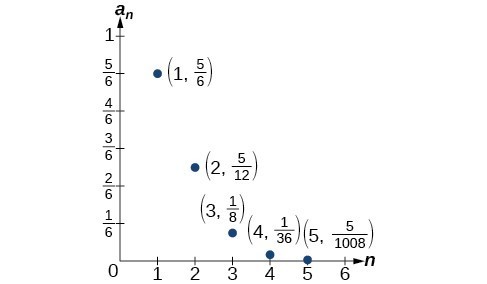Learning Outcomes
- Write terms of a sequence defined by a recursive formula
- Write terms of a sequence using factorial notation
Sequences occur naturally in the growth patterns of nautilus shells, pinecones, tree branches, and many other natural structures. We may see the sequence in the leaf or branch arrangement, the number of petals of a flower, or the pattern of the chambers in a nautilus shell. Their growth follows the Fibonacci sequence, a famous sequence in which each term can be found by adding the preceding two terms. The numbers in the sequence are 1, 1, 2, 3, 5, 8, 13, 21, 34,…. Other examples from the natural world that exhibit the Fibonacci sequence are the Calla Lily, which has just one petal, the Black-Eyed Susan with 13 petals, and different varieties of daisies that may have 21 or 34 petals.
Each term of the Fibonacci sequence depends on the terms that come before it. The Fibonacci sequence cannot easily be written using an explicit formula. Instead, we describe the sequence using a recursive formula, a formula that defines the terms of a sequence using previous terms.
A recursive formula always has two parts: the value of an initial term (or terms), and an equation defining [latex]{a}_{n}[/latex] in terms of preceding terms. For example, suppose we know the following:
[latex]\begin{align}{a}_{1}&=3 \\ {a}_{n}&=2{a}_{n - 1}-1, \text{for } n\ge 2 \end{align}[/latex]
We can find the subsequent terms of the sequence using the first term.
[latex]\begin{align}{a}_{1}&=3\\ {a}_{2}&=2{a}_{1}-1=2\left(3\right)-1=5\\ {a}_{3}&=2{a}_{2}-1=2\left(5\right)-1=9\\ {a}_{4}&=2{a}_{3}-1=2\left(9\right)-1=17\end{align}[/latex]
So the first four terms of the sequence are [latex]\left\{3,5,9,17\right\}[/latex].
The recursive formula for the Fibonacci sequence states the first two terms and defines each successive term as the sum of the preceding two terms.
[latex]\begin{align}{a}_{1}&=1 \\ {a}_{2}&=1 \\ {a}_{n}&={a}_{n - 1}+{a}_{n - 2}, \text{for } n\ge 3 \end{align}[/latex]
To find the tenth term of the sequence, for example, we would need to add the eighth and ninth terms. We saw above that the eighth and ninth terms are 21 and 34, so
[latex]{a}_{10}={a}_{9}+{a}_{8}=34+21=55[/latex]
A General Note: Recursive Formula
A recursive formula is a formula that defines each term of a sequence using preceding term(s). Recursive formulas must always state the initial term, or terms, of the sequence.
Q & A
Must the first two terms always be given in a recursive formula?
No. The Fibonacci sequence defines each term using the two preceding terms, but many recursive formulas define each term using only one preceding term. These sequences need only the first term to be defined.
How To: Given a recursive formula with only the first term provided, write the first [latex]n[/latex] terms of a sequence.
- Identify the initial term, [latex]{a}_{1}[/latex], which is given as part of the formula. This is the first term.
- To find the second term, [latex]{a}_{2}[/latex], substitute the initial term into the formula for [latex]{a}_{n - 1}[/latex]. Solve.
- To find the third term, [latex]{a}_{3}[/latex], substitute the second term into the formula. Solve.
- Repeat until you have solved for the [latex]n\text{th}[/latex] term.
Example: Writing the Terms of a Sequence Defined by a Recursive Formula
Write the first five terms of the sequence defined by the recursive formula.
[latex]\begin{align} {a}_{1}&=9 \\ {a}_{n}&=3{a}_{n - 1}-20\text{, for }n\ge 2 \end{align}[/latex]
Try It
Write the first five terms of the sequence defined by the recursive formula.
[latex]\begin{align}{a}_{1}&=2\\ {a}_{n}&=2{a}_{n - 1}+1\text{, for }n\ge 2\end{align}[/latex]
Using Factorial Notation
The formulas for some sequences include products of consecutive positive integers. [latex]n[/latex] factorial, written as [latex]n![/latex], is the product of the positive integers from 1 to [latex]n[/latex]. For example,
An example of formula containing a factorial is [latex]{a}_{n}=\left(n+1\right)![/latex]. The sixth term of the sequence can be found by substituting 6 for [latex]n[/latex].
The factorial of any whole number [latex]n[/latex] is [latex]n\left(n - 1\right)![/latex] We can therefore also think of [latex]5![/latex] as [latex]5\cdot 4!\text{.}[/latex]
A GENERAL NOTE: FACTORIAL
n factorial is a mathematical operation that can be defined using a recursive formula. The factorial of [latex]n[/latex], denoted [latex]n![/latex], is defined for a positive integer [latex]n[/latex] as:
The special case [latex]0![/latex] is defined as [latex]0!=1[/latex].
Try It
Q & A
CAN FACTORIALS ALWAYS BE FOUND USING A CALCULATOR?
No. Factorials get large very quickly—faster than even exponential functions! When the output gets too large for the calculator, it will not be able to calculate the factorial.
EXAMPLE: WRITING THE TERMS OF A SEQUENCE USING FACTORIALS
Write the first five terms of the sequence defined by the explicit formula [latex]{a}_{n}=\dfrac{5n}{\left(n+2\right)!}[/latex].
Try It
Write the first five terms of the sequence defined by the explicit formula [latex]{a}_{n}=\dfrac{\left(n+1\right)!}{2n}[/latex].
Candela Citations
- Revision and Adaptation. Provided by: Lumen Learning. License: CC BY: Attribution
- College Algebra. Authored by: Abramson, Jay et al.. Provided by: OpenStax. Located at: http://cnx.org/contents/9b08c294-057f-4201-9f48-5d6ad992740d@5.2. License: CC BY: Attribution. License Terms: Download for free at http://cnx.org/contents/9b08c294-057f-4201-9f48-5d6ad992740d@5.2
- Question ID 5812. Authored by: David Lippman. License: CC BY: Attribution. License Terms: IMathAS Community LicenseCC-BY + GPL
- Question ID 6107 . Authored by: Gregg Harbaugh. License: CC BY: Attribution. License Terms: IMathAS Community License CC-BY + GPL
- Question ID 19458. Authored by: James Sousa. License: CC BY: Attribution. License Terms: IMathAS Community License CC-BY + GPL
- Question ID 5846. Authored by: WebWork-Rochester. License: CC BY: Attribution. License Terms: IMathAS Community License CC-BY + GPL
- Question ID 68773. Authored by: Roy Shahbazian. License: CC BY: Attribution. License Terms: IMathAS Community License CC-BY + GPL
- Precalculus. Authored by: OpenStax College. Provided by: OpenStax. Located at: http://cnx.org/contents/fd53eae1-fa23-47c7-bb1b-972349835c3c@5.175:1/Preface. License: CC BY: Attribution

